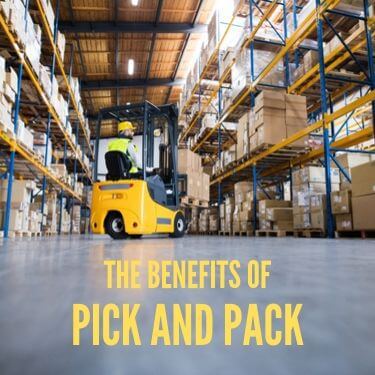
 Copy URL to Clipboard
Copy URL to Clipboard
Today, when you place an order for something online, it’s possible for it to arrive on your doorstep the same day. While drones and other technology advancements are to be thanked for that, what about the delivery speed of a logistics company?
One such reason these companies can promise speed as well as efficiency is due to a process known as pick and pack. While you may be familiar with the term pick and pack, perhaps you’ve never considered it for your own logistics company before. After all, if the speed in which you’re working is enough to please your customers, then why make any changes?
With a new year upon us and further advancements in technology always ready to change the game, there’s never a good time to get complacent. If your company could be doing more to improve the lives of your customers, it’s worth a try. One such method you might consider then is pick and pack.
If you’re curious about what pick and pack is and you’re eager to learn more, you’ve come to the right place. In this heavily detailed guide, we will explain everything you need to know about pick and pack, or order processing. We’ll start with a definition, then a glimpse into the pick and pack process. We’ll dive into benefits, challenges, and fees so you can an educated decision for your logistics company.
Table of Contents

Your logistics company undoubtedly has a supply-chain management. This allows your services and goods to move from supplier or retailer and into the hands of your customers. This is known as the supply chain.
Pick and pack is a part of the greater supply-chain management. It’s one cog in the wheel that keeps the whole thing moving flawlessly. This order fulfillment is popular among eCommerce or Internet brands that have customers all over the world. That’s because of the way items are prepared, which is hinted at in the name.
With pick and pack logistics, the warehouse employees at the eCommerce company will work from master cartons. There will be many of these cartons on each shelf of a warehouse. The workers will take the relevant items from each master carton. This is the picking part of pick and pack.
Next, the worker will take the item and put it in an envelope or box to be sent to the customer. This is where the packing part of the name comes from. The customer then happily receives their package.
A similar concept to pick and pack is known as case picking. This is not an interchangeable term, though. When workers are case picking, they will choose items from product boxes or cartons. Said boxes or cartons typically arrive via pallets.

Now that we’ve defined what pick and pack is, let’s explore how it works via a process. While it may seem obvious on the surface how pick and pack works, if you’re considering this system for your logistics company, you need to know all the details.
On that note, we do want to mention that the pick and pack system that logistics companies implement can vary from one business to another. To understand why that is, be sure to read on to the next section. In it, we’ll discuss all the factors that make pick and pack a worthwhile system for many logistics companies.
For now, let’s get into the process of pick and pack.
It should come as no surprise that the first stage of the pick and pack process is picking. It should be mentioned that the workers who do the pick and pack process are rarely working exclusively on their own. Instead, they’ll often use a warehouse management system. This is software that most distribution centers and logistics companies use. From checking resources to directing tasks, planning shipping, and more, a warehouse management system is integral.
In the first step of the pick and pack process, the warehouse management system will send an order to the warehouse. The workers will receive the order. If you have a more advanced warehouse management system, it should be designed for efficiency. For instance, there should b no overlap in orders. There’s even a way to cut down on the distance the workers had to walk to get to the master cartons. This saves times and improves productivity and efficiency.
After receiving the order, the worker will go to the master carton and access the item or items they need for order fulfillment. This is the end of the picking part of the process.
Next, we move onto the packing part of the equation. If the customer ordered just a single item, this is easy enough to organize. Bigger orders need to be grouped together and organized in one place so one of the items doesn’t accidentally go missing. This is a major part of the packing process.
The will prepare the packing material, be that a box, pallet, envelope, carton, bag, or other vessel. They may also include promotional materials depending on the nature of the company. The customer’s printed receipt with the order information should be packed in, as will dunnage. This may include wood, foam, or packing peanuts. The dunnage is meant to keep the customer’s item or items from moving too freely in the package.
Adding dunnage then, as you can imagine, is quite a crucial step. While sometimes the contents of the package can still end up broken when dunnage is added, the chances of this happening are reduced. At that point, it’s also more on the post office and mishandling than it would be the company the customer ordered from.
Once the items, promotional materials, dunnage, and receipt are loaded into the box, the worker isn’t done yet. They also have to print out a shipping label and stick it onto the box. As the worker gives up the box to work on another, it will go through a quality assurance stage to be checked. A computerized system might inspect the box or a person might do it.
During this quality assurance stage, the box is being checked for visible damage or other issues. If the shipping label was forgotten or began to unstick and come off, this would also be addressed. The box would either be returned to the worker to fix or someone else along the chain would take care of this job.
Now the box will leave the warehouse and into the hands of a shipping company. Some logistics companies do take care of shipping themselves, in which case the box would still get shipped. There would just be no third parties involved.
Once the box is shipped, the company will likely send out a shipping notification email to the customer. This is done online. A tracking number will be provided with the email so the customer can watch along as their package gets closer and closer to their door.
That is essentially the pick and pack process in a nutshell. It’s always possible that some logistics companies may wish to change up certain elements of the work. If that makes a pick and pack system more efficient for your company, then by all means, do what works best for you.
Those companies that make no changes will have a pick and pack process that reliably repeats as per the information above.

In trying to decide if your own logistics company should implement a pick and pack system, you’re going to want to know which factors can influence success. The truth is that, at the end of the day, no two logistic companies are exactly alike. Therefore, if pick and pack works for one, it may not necessarily be as suitable for a second one.
In this section, we are going to go over the factors that can influence the efficiency of a pick and pack system. Make sure you take each and every factor into account as you decide what the future of your logistics company will be.
Is your logistics company one that relies on tried-and-true methods or do you jump on the newest trends and methods as soon as these emerge? Perhaps you’re somewhere in between. This is probably ideal for a pick and pack system, as is an older-school means of dealing with logistics.
What you need for a pick and pack system to succeed is stability, especially when it comes to your distribution network. Even minor changes can throw a pick and pack system out of whack, interrupting which packages go to whom and how fast. If your logistics company has used the same distribution network for some time, then it might be worth seriously considering implementing a pick and pack system. Those companies that update distribution networks often may want to reconsider this method.
What is the order volume of the eCommerce retailer you do business with now? Are they a newer company or an established one like Amazon with massive order volume? You must ask these questions to get a gauge on what their future order volume will look like. A newer company could fold within a few years, which is unfortunate but sometimes true. Older, more trusted retailers can still sometimes fall apart internally, especially as bricks and mortar retail continues to fail.
You likely went through a vouching process for the businesses and retailers your logistics company works with. You can trust in them. If you can also relatively accurately predict a future high order volume, then a pick and pack system is a great means of getting items shipped out. If you have doubts about future order volume, then it may be best to hold off on implementing a pick and pack system at this moment.
Does the eCommerce retailer you work with produce seasonal items? Perhaps they’re a swimming pool company, for example. If so, then the dead season for them will be from after Labor Day until Memorial Day. That is quite a lot of downtime in which orders placed will be low to nonexistent.
A pick and pack system isn’t the best fit for a company that only does seasonal orders. You’re better off maintaining whatever shipping system you already have in place for specialty clients like seasonal ones.

What do you ship your products in? Is it typically packing materials like envelopes and boxes or do you deal with pallets, totes, and cases as well? The pick and pack system is a streamlined one that’s designed for speed and efficiency. However, it can be slowed down. Having too many options is one such way to do that.
When the warehouse workers have to choose from pallets, totes, and cases as well as traditional boxes and envelopes, their efficiency can decrease. With some training, it is possible for these workers to use a pick and pack system even with so many shipping package options. This will not happen overnight.
You’d have to be willing to put the time and training expenses into showing workers how to quickly pick and pack with all those package choices. If you are, then a pick and pack system could work. If not, then it’s better to use a different system altogether.
Pick and pack systems work best with high quantities of products to be shipped. However, how many items make up a single order? For instance, Amazon has an Add-on program. All Add-on Items must comprise $25 total when combined. Depending on what it is the customer orders, the quantity could increase or decrease.
As an example, the wants a set of pencils or pens. A pack of pencils may be between $3 and $5 depending on which brand a customer chose. If the pencils were $3, the customer would have to order more than eight packs to take advantage of the Amazon Add-on Item deal. If the writing instruments cost $5, then they’d need five packs.
However, skincare items are also a part of Amazon’s Add-on program. Let’s say a customer bought a six-pack of Dove soap. Each soap is four ounces. This is an Add-on Item, too. It costs about $7 for the pack. The customer would need to buy about four packs of soap.
With a pick and pack system, the workers are typically looking for single items. The master cartons would have to be incredibly well-organized for them to find eight packs of pencils or four packs of soap. The workers would also have to have a near perfect memory to recall the exact quantity of each item they’re seeking and then load them all into one box or envelope.
That’s not to say a pick and pack system is a bad idea if you have a system like Amazon’s Add-on program. It just takes more work to train employees on a pick and pack system.
The final factor we implore you to consider is the products themselves. If you work with a retailer that ships all sorts of items, this too can sometimes hinder the pick and pack process. After all, edible items, as you’d imagine, would not have the same fulfillment process as shipping non-edible ones do. Even the nature of the edible food differs. A box of cereal is relatively hardy and unlikely to be damaged unless seriously mishandled. The same cannot be said of eggs. These need to be treated extremely gingerly and packed lightly to avoid crushing, damaging, or breaking them before they can get to the customer.

Thus far, we’ve introduced the concept of the pick and pack system and explained the necessary processes in detail. We’ve also explained that there are many factors that can influence how viable a pick and pack system would be for your logistics company.
You may still be undecided right now if you want to implement pick and pack. That’s okay. To help guide your decision, in this section of the guide, we will outline the multiple benefits of a pick and pack system.
The first benefit is a greater packing and shipping speed. While it’s true you will need to either a.) hire fast employees or b.) train the employees you already have, once you have employees that know what they’re doing, the entire process becomes streamlined.
These employees know exactly what to look for to fulfill an order and where to go to get it. They’re familiar with packing products the right way so the item isn’t at risk of breaking. They can slap on the shipping label quickly and get the package off to the next stage, be that your own shipping method or a third-party shipper.
Speed can be careless in some instances, but your trained employees are anything but. In fact, they’re very efficient at what they do. The more often your employees use the pick and pack system, the more familiar they will become with it. That improves their ability to do the job quickly yet without sacrificing quality with their speed.
If you can expect high-quality results each time, then the efficiency of the pick and pack system increases. That makes it a reliable option for logistics companies who are looking to get more shipped items out the door faster.
An organized warehouse sets the stage for the success of a pick and pack system. When all the items in the master cartons are clearly labeled or put together in similar groups, this makes the job of the workers much easier. There’s no need to waste valuable time going from one master carton to another hoping to find what they need. They also don’t have to stop and ask another coworker or even a higher-up about the location of the item in question.
Instead, they know just where to find everything every time. While the organization of a pick and pack system can’t necessarily be attributed to the workers who are picking and packing items, it’s a crucial part of their job success and the success of your logistics company.
Another area in which an organized pick and pack system shines is accuracy. Not only does an organized warehouse allow employees to work quickly, but it improves their accuracy. When you’re fulfilling orders for your customers, you can’t afford to send them the wrong thing. If they want Product A, then Product C will not work. It’s just not a suitable alternative. Even if you run out of Product A, it’s better to hold off on sending out the order or send only a partial order instead of fulfilling the order with a random replacement.
The accuracy of your pick and pack team must be completely accurate, then. With an organized warehouse and trained workers, you can ensure that’s the case.
Your workers are people at the end of the day, and distractions do happen. While you want to minimize these as much as possible, sometimes it’s hard to do so. By switching to a pick and pack system, you can see greater productivity from hour to hour and day to day.
While your employees will of course take breaks, when they’re on the clock, they’re working in a fast, efficient way. The packages that are shipped out have a higher accuracy rate. With more orders fulfilled, your company can grow in new ways, increasing revenue and retaining customers while locking in new ones.
While we will touch on the fees of a pick and pack system in the next section, we did want to mention here that it generally costs less money than you’d expect to set up such a system.
Finally, by combining a speedier 3PL warehouse that works accurately and efficiently, your customers get what they need faster. If they know they can count on a company each time for reliable product delivery that’s also quick, they’ll continue to give their repeat business.
Every company wants greater customer satisfaction. A pick and pack system could be part of the key.

As we mentioned, we’d elaborate on the warehouse fees of a pick and pack system. While pick and pack is regarded as a cheaper option, it’s not free. There are a slew of charges that can crop up during the order fulfillment process. These include:
While these may seem like a lot of costs when viewed all at once, if you did a loose total, you’re likely to end up saving money with a pick and pack system.

That’s not to say that the pick and pack system is flawless, because it certainly isn’t. If your logistics company has decided to implement such a system going forward, you should know there are several challenges companies often face.
If these are dealt with early enough, it’s possible to overcome most of these challenges. That frees the way for your workforce to be more productive and your company to succeed. In this section, we will go over the challenges. Make sure you read on to the next section, as we’ll present some solutions.
For a pick and pack system to work optimally, all the employees must share a common goal: order fulfillment. However, they also have to be careful not to get in each other’s ways while doing their respective jobs.
In our benefits system, we mentioned how crucial an organized warehouse is to the pick and pack system working well. If the warehouse is a mess or stock isn’t sorted through and organized, all this is doing is slowing the pick and pack workers down. That leads to fewer orders being fulfilled and stock piling up without being addressed.
Doing the same thing day in and day out gets tiring. In a pick and pack system, the reality is the job can be repetitive. Employees can get burnt out. Others might decide they need a career change and leave.
While the fees we outlined above may not be expensive for some logistics companies, smaller or newer companies may have a hard time paying the costs of a pick and pack system. There are also sometimes unexpected expenses that can be quite pricy.

Perhaps some of the problems we just covered resonate with you. You could also be worried about those problems hypothetically happening in the future. If so, do be aware that every challenge has a solution. By changing the means in which your employees go through the pick and pack system, it’s possible to increase or maintain productivity without burnout. Coordination and organization can also remain top priorities, as can reducing fees.
The process of zone picking entails creating zones throughout the warehouse. This is a great solution if keeping the warehouse organized is your problem. Groups of employees will have their own zones that they stick to. If a package needs to go to another zone, the employees can transport it there using conveyor belts or even doing so by hand.
The next solution is batch picking. If you have a lot of employees or staff, then batch picking may be a viable solution. That’s because the workers are choosier about the items they select. They will get groups or batches of orders and select the items that fulfill the order from there. The employees could be fulfilling several orders at once with batch picking.
The best parts of batch picking and zone picking are combined with wave picking. There’s the batch picking mentality, but now it’s limited down to zones. This improves organization, accuracy, speed, and efficiency, making it a great solution.
Finally, there’s piece picking. This is one of the easier pick and pack solutions. Under piece picking, employees go through single orders one-by-one in the order they arrive to the warehouse. Then they go through the standard pick and pack process we discussed earlier in the guide. This is intended for small logistics company with a warehouse that doesn’t have as many employees.
Pick and pack is a means of order fulfillment. Workers receive orders and then go to master cartons to fill the orders. The orders are packed, labeled, and then shipped out once they pass quality control.
While a pick and pack system might not work for every logistics company, there are many benefits. You can improve employee efficiency, fulfill more orders daily, and retain many pleased customers. That makes a pick and pack system worth considering at the very least.
Take advantage of R+L Global fulfillment and distribution services for your pick and pack needs. We offer:
